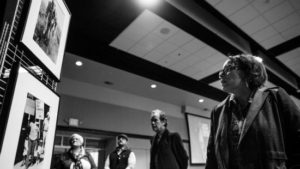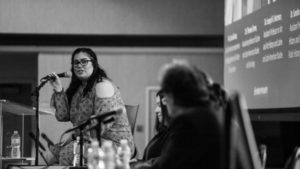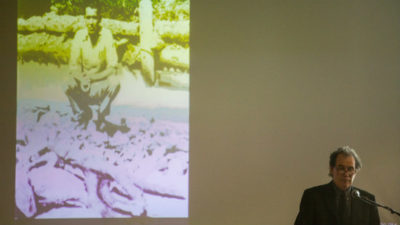Annual lecture honors legacy of César Chávez
José Galvez, Pulitzer Prize-winning photographer, has been focusing his camera lens on the Latin American community for more than 40 years. On April 17, Galvez shared his photos and experiences with the University of Missouri Kansas-City community when he gave the 11th Annual César Chávez Lecture.
One of UMKC’s primary roles as Kansas City’s university is to be a thought stimulator, said Susan Wilson, Ph.D., vice chancellor of the UMKC Division of Diversity and Inclusion and sponsor of the lecture. The lecture series honors the accomplishments of Chavez, organizer of the Chicano movement in the United States and founder of the United Farm Workers. The event also raises awareness of the continual struggle for civil rights including humane working conditions, dignity, equality and access to opportunity for all.
“Today we honor César Chávez,” Galvez said. “You are not forgotten.”
Galvez began his talk with some statistics:
- According to the 1980 U.S. Census, the Latino population was 14.6 million
- By 2000, the number had grown to 35.3 million
- As of July 2015, there were 56.5 million Hispanics living in the U.S.
- Right now Hispanics/Latinos comprise about 17 percent of the population and account for more than half the growth in the population
- By 2060, the estimates are that Latinos could be 30 percent of the population, or one in three
- The sales receipts for Hispanic-owned businesses in America topped $547 billion 2013 and Latinos had about $1.7 trillion in buying power
“We are a multifaceted people,” Galvez said. “We are here to stay. What happens in the next few years will define us.”
In the 1960s and 70s, Galvez said people didn’t want to be labeled by the government. But people found unity among themselves and strove to create their own identity.
“We are a coherent group,” Galvez said. “A Chicano/Chicana is an American-born person of Mexican decent. I’m not sure who thought of it first, but we carried it with pride.”
While the name helped some identify themselves, Galvez said not everyone embraced the word. For those who didn’t, they were the voiceless, especially among the working farmers.
Chavez noticed this and stepped up. Chavez fought for better working conditions for farm workers. He fought for safe working conditions and better living conditions.
“Does this sound familiar?” Galvez asked the attendees. “Because the fight goes on.”
In some ways, Galvez said things are not much different today than they were in the ‘60s and ‘70s. He said he notices that in the photographs he takes every day.
As Galvez talked about his life and the life of Chavez, pictures scrolled on a screen behind him. The pictures were of children, families and farm workers. Galvez talked about a defining moment for the Chicano movement in Tucson. With the development of new “opportunities,” such as the Tucson Convention Center, he said city leaders saw growth, development and jobs.
“What we saw were people losing their homes,” Galvez said. “We saw communities as risk. And so we marched. And Cesar Chavez came. He came to help us.”
Galvez was in Tucson to capture the march on film. In the end, he said they lost the fight and the barrio was bulldozed. The convention center was built. But it never drew as many people as promised. He said there will never be enough hotels and places for people to stay. And the barrio will never come back.
“A consciousness was born in me that I have not yet let go of,” Galvez said. “I took it upon myself to document the protests and the marches with passion.”
 Galvez’s work moved him from Arizona to California. In 1984, while at the Los Angeles Times, Galvez and a team of reporters and photographers won a Pulitzer Prize for a series on Latino life in Southern California. Galvez’s path crossed again with Chavez while at the Los Angeles Times. He covered Chavez more frequently and recalled Chavez’s last fast in 1988. Galvez captured it on film.
Galvez’s work moved him from Arizona to California. In 1984, while at the Los Angeles Times, Galvez and a team of reporters and photographers won a Pulitzer Prize for a series on Latino life in Southern California. Galvez’s path crossed again with Chavez while at the Los Angeles Times. He covered Chavez more frequently and recalled Chavez’s last fast in 1988. Galvez captured it on film.
“He went without food to call attention to the pesticides used in the fields,” Galvez said. “It was said his health was never the same after that.”
Galvez keeps the memory of Chavez alive by capturing moments in life on film, by speaking to the public and sharing his experiences and photos. The pictures that continued across the screen during his talk at UMKC always went back to the workers. Chavez died five years after that last fast. And on the anniversary of Chavez’s death, April 23, 1993, Galvez said we celebrate his life.
“His work goes on and his legacy lives on,” Galvez said. “I pay tribute to the men and women like this every day when I stop by construction sites to get pictures of men on the roof. Or the maids in a hotel.”
To the people in the audience, Galvez said, “You are planting seeds. They are good seeds. Keep the faith. I’ll keep taking the photos.”
The evening ended with a panel discussion with questions and answers to further the conversation of the Chicano movement, the photography of Galvez and activism in Kansas City. Panelists included Galvez and members of the Latinx and Latin American Studies Program: Sandra Enríquez, Ph.D., assistant professor; Joseph R. Hartman, Ph.D., assistant professor; and Theresa Torres, Ph.D., associate professor.
 The panel was moderated by Juliana Ayala, senior psychology student with a minor in Latin American Studies. The lecture with Galvez was supported by the UMKC Latinx and Latin American Studies Program and the UMKC Department of Art and Art History.
The panel was moderated by Juliana Ayala, senior psychology student with a minor in Latin American Studies. The lecture with Galvez was supported by the UMKC Latinx and Latin American Studies Program and the UMKC Department of Art and Art History.

